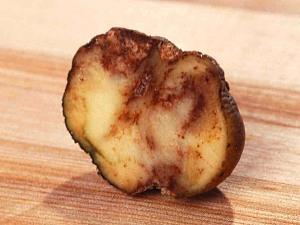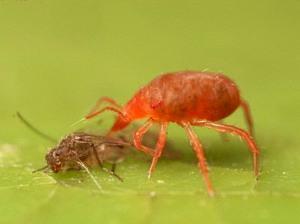We study the main plant diseases to prevent their spread
Late blight
 One of the most common plant diseases is late blight. It usually affects vegetable crops such as potatoes, tomatoes, peppers, eggplants. There are known cases of late blight infection of even flowers, for example, violets. Late blight is insidious for citrus plants and even for strawberries. The cause of the disease is the fungus Phytophthora infestans. It penetrates deeply into the plant, causing great harm to it.
One of the most common plant diseases is late blight. It usually affects vegetable crops such as potatoes, tomatoes, peppers, eggplants. There are known cases of late blight infection of even flowers, for example, violets. Late blight is insidious for citrus plants and even for strawberries. The cause of the disease is the fungus Phytophthora infestans. It penetrates deeply into the plant, causing great harm to it.
It is very easy to recognize late blight. The leaves of the infected plants begin to turn brownish-brown. This unusual color is especially evident after rain with the onset of warm weather. The sun is a kind of catalyst for late blight. As a result, the plant turns black and gradually dies.
Plants infected with late blight mold are not suitable for consumption. The potato tubers become gray in color, and when the potato is cut it is brownish brown. The fact that the plant is infected can be determined by the potato tops, which, instead of a juicy green color, acquire a brown tint. In this case, it is necessary to immediately cut off the tops, and the potatoes should be well spud. If the disease has not reached the tubers, then there is still a chance to save the crop. Infected tops should be destroyed, but never thrown into the compost pit.
Preventive work against late blight should be carried out with tomatoes. It is best to treat it with special preparations for late blight at an early stage of plant growth, or 1% Bordeaux liquid. You can also prepare a soap solution consisting of 20 g of copper sulfate, 200 g of laundry soap. Dissolve them in 10 liters of water. It is best to carry out procedures in sunny weather.
Spider mite
Many plants are susceptible to spider mite infection, for example, cucumbers... In a diseased plant, light dots will appear on the leaves, and then spotted marbling. This is a sign that the female spider mite has already laid eggs. To save a plant from a pest, it is necessary first of all to apply special means designed to combat ticks. For example, "Bicol" or "Bitoxibacillin". If there are none at hand, then cucumbers can be sprayed with infusion made from potato tops.
The main condition: the tops should not be infected with late blight. The infusion is prepared as follows: 1 kg of green, healthy tops is well crushed, placed in a container and filled with 10 liters of water. It is enough to infuse the mixture for 3-4 hours, after which it is ready for action.
A spider mite can bring great harm to immature plants, for example, seedlings of peppers, eggplant, tomatoes. In this regard, you should carefully consider the young leaves of plants, especially from the reverse side. If a thinnest web is found, it is necessary to spray the seedlings with special preparations.
Scab
Very often on the peel of apples, pears, potatoes, you can see dark, dry, unpleasant to touch spots. This is a consequence of the influence of a microscopic parasitic fungus - scab.
Scab penetrates the plant, it is able to infect all its parts: leaves, fruits, stems and even flowers. Under the influence of the disease, the fruits are strongly deformed, the leaves weaken, crumble ahead of time. They should be removed immediately, and when they are a little dry, burned, since it is on the leaves that pathogens can overwinter.
The disease is especially severe in wet weather. This is due to the fact that spores of the parasitic fungus develop in a droplet-liquid medium. That is why, if spring and summer are rainy, when harvesting, for example, potatoes, a lot of tubers are affected.
However, unlike late blight disease potatoes with scab is usable. Do not get infected from each other with scab, for example, the fruits of the apple and pear.
However, scab should be dealt with. For this plant it is best to spray it with Bordeaux liquid or 0.3% copper oxychloride solution.

I fully agree with the author of the article that late blight is a very common and insidious disease. It affects many crops, but tomatoes are the least resistant to it. Several years ago I had wonderful tomatoes in my garden, it rained for several days, then the sun. I went out into the garden, and instead of tomatoes, black stems, withered leaves. Since then, I have followed this very closely. Three times a season I spray tomatoes (1 - seedlings in a greenhouse, 2 - when they take root in the open field, 3 - when there are green fruits). I use different fungicides, most often Redomil and Confidor.
Phytophthora, scab, spider mite. The misfortunes are different, but the result is the same - the plant and the harvest are ruining. There are many insecticides from spider mites, but as an ambulance I use the most harmless one, Fitoverm. Better biological - Bitoxibacillin. I like the ability to sterilize females. The population decreases markedly in the greenhouse and the next year development begins much later. There was one lousy patch on the potatoes. The kind man advised to pick up ordinary moss in the swamp and throw a piece into the hole when planting. It helped us, maybe someone else will need experience. For two years in a row, they threw it and forgot about the scab, and for a long time they found pieces of moss in the garden. It is more difficult with late blight of tubers. We came to the conclusion that it was necessary to fight from the spring, and to harvest the harvest earlier than the rains began. Then, harvested in clear weather, well dried and aged in the dark, potatoes do not get sick. We will lose a bag from early cleaning, but we do not throw out half of it in the middle of winter.